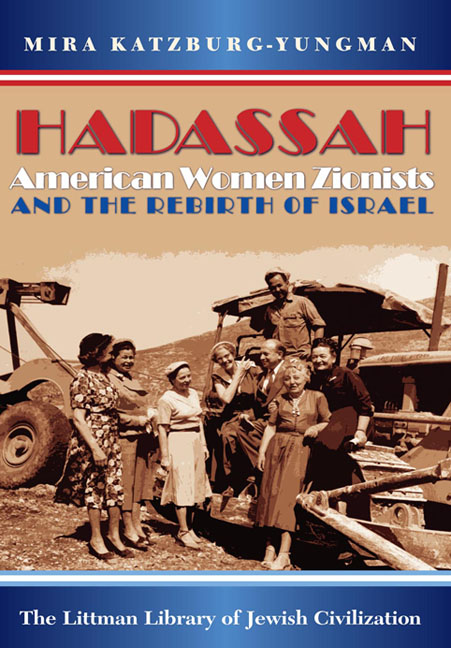Book contents
- Frontmatter
- Dedication
- Preface and Acknowledgements
- Contents
- List of Plates
- Note on Transliteration
- Prologue
- PART I CONTEXTS AND CHALLENGES
- 1 Hadassah, 1912–1933: Finding a Role
- 2 Hadassah, 1933–1947: Responding to Crisis
- 3 The Leadership
- PART II THE AMERICAN SCENE: IDEOLOGY AND PRACTICE
- PART III THE WORLD ZIONIST ORGANIZATION SCENE
- PART IV THE ISRAELI SCENE: HADASSAH AND THE NEW STATE
- PART V HADASSAH IN CONTEXT
- APPENDICES
- Bibliography
- Plate Acknowledgements
- Index
2 - Hadassah, 1933–1947: Responding to Crisis
from PART I - CONTEXTS AND CHALLENGES
- Frontmatter
- Dedication
- Preface and Acknowledgements
- Contents
- List of Plates
- Note on Transliteration
- Prologue
- PART I CONTEXTS AND CHALLENGES
- 1 Hadassah, 1912–1933: Finding a Role
- 2 Hadassah, 1933–1947: Responding to Crisis
- 3 The Leadership
- PART II THE AMERICAN SCENE: IDEOLOGY AND PRACTICE
- PART III THE WORLD ZIONIST ORGANIZATION SCENE
- PART IV THE ISRAELI SCENE: HADASSAH AND THE NEW STATE
- PART V HADASSAH IN CONTEXT
- APPENDICES
- Bibliography
- Plate Acknowledgements
- Index
Summary
NAZISM, THE SECOND WORLD WAR, AND THE ZIONIST STRUGGLE
Hadassah Expands in Scale and Scope
The rise of Hitler to power in 1933, and the consequent challenge of coping with the problem of the Jewish refugees from Germany, led to an expansion both of Hadassah's activity and of the organization itself. In 1935 Hadassah became the US patron of Youth Aliyah, which had been founded in Germany in 1932 with the aim of facilitating the emigration of Jewish children and teenagers to Palestine. Hadassah's decision to take on this responsibility was based not only on the pressing humanitarian need, but also on its own wish to find additional projects besides its health-care work in Palestine. The early 1930s saw a steep decline in the membership of Hadassah, as in that of other American Jewish organizations, as a result of the Great Depression, and its leaders reached the conclusion that its health projects in Palestine were not attracting enough members. In order to increase the size of the membership, they believed, it was necessary to take on another enterprise. This view gained support when the problem of German Jewish refugees arose: many women joined Hadassah because of this development and raised the question, which was also being put by some veteran members, whether good hospital care in Palestine was the most urgent priority on their agenda as Jewish women at this time.
Among the leading figures in Hadassah in favour of taking on Youth Aliyah was Rose Gell Jacobs. One of Hadassah's founders, and its national president in 1930–2 and again in 1934–7, she was considered the organization's most important leader after Henrietta Szold. Rose Jacobs thought that Youth Aliyah would link Hadassah with the problems of world Jewry, and create a link between America, Europe, and Palestine. Moreover, the work of Youth Aliyah was consistent with the first mission that Hadassah had adopted when it was founded: namely, practical and concrete work in Palestine for women and children.
Hadassah's adoption of Youth Aliyah provoked a considerable response. Vast sums of money were rapidly donated, and in just two years from 1935 to 1937 Hadassah raised $250,000 for the project.
- Type
- Chapter
- Information
- HadassahAmerican Women Zionists and the Rebirth of Israel, pp. 34 - 53Publisher: Liverpool University PressPrint publication year: 2011

